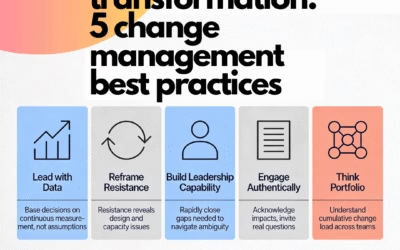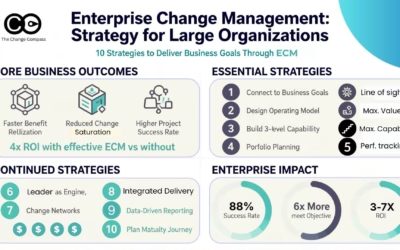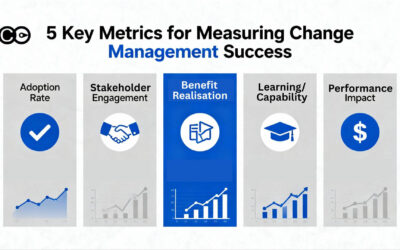Level 1: Air Traffic Control—Establishing Oversight and Laying the Foundation
Seasoned transformation and change practitioners know the challenge: senior leaders are rarely interested in “change training” but are critical to the success of your change portfolio. Their engagement, understanding, and decision-making set the tone for the entire organization. The question is not how to send them to a course, but how to build their change literacy in a way that is practical, relevant, and embedded in their business agenda.
Here we explore a pragmatic approach to developing senior leaders’ maturity in managing a portfolio of change. In Level 1, we focus on the “Air Traffic Control” phase—establishing initial oversight, surfacing key data, and creating the conditions for informed leadership.
Why Change Literacy Matters at the Top
For senior leaders change portfolio literacy is more than understanding the mechanics of change management. For senior leaders, it’s about:
- Seeing the full landscape of change across the business.
- Understanding the cumulative impacts on people, operations, and strategy.
- Making informed decisions on priorities, pace, and resource allocation.
Without this literacy, leaders risk overwhelming teams, missing strategic opportunities, and failing to deliver on business benefits. The stakes are high: the volume and velocity of change in most organizations today mean that “flying blind” is not an option.
The Air Traffic Control Phase: Creating Oversight and Clarity
The first step in building change literacy is not education—it’s exposure. Like an air traffic controller, senior leaders must be able to see all the “planes in the sky” before they can direct traffic safely and efficiently.
Key Objectives in This Phase:
- Establish visibility of all change initiatives.
- Surface capacity constraints and people impacts.
- Create a shared language and baseline understanding of change activity.
1. Map the Change Landscape
Start by working with your PMO, HR, and transformation teams to create a comprehensive map of all current and upcoming change initiatives. This should include:
- Project names, sponsors, and owners.
- Timelines and key milestones.
- Impacted business areas and stakeholder groups.
- Resource requirements (people, budget, technology).
Tip: Visual tools such as rollout timelines, calendars, or dashboards are invaluable. They help leaders “see the forest for the trees” and spot potential collisions or overloads.
2. Quantify Capacity and Performance
Next, introduce data on organizational capacity and people performance:
- How many initiatives are impacting each business unit?
- Where are the pinch points in terms of workload, skills, or engagement?
- What is the current state of change fatigue or readiness?
This data grounds the conversation in facts, not anecdotes. It also begins to shift the mindset from project-by-project thinking to portfolio-level oversight.
3. Connect to Business Priorities
Senior leaders are motivated by what’s on their agenda: strategic goals, operational performance, risk, and efficiency/growth. Frame the change portfolio in these terms:
- Which initiatives are directly tied to strategic objectives?
- Where are there conflicts, duplication, or misalignment?
- What are the risks to business performance if changes are poorly sequenced or resourced?
By connecting change data to business outcomes, you make the conversation relevant and urgent.
4. Facilitate the Right Conversations
Rather than presenting data for its own sake, design conversations that help leaders make better decisions:
- Where do we need to slow down or pause initiatives to protect capacity?
- How can we sequence changes to maximize benefits and minimize disruption?
- What trade-offs are required to align with strategic priorities?
These discussions are not about “managing change” in the abstract—they are about running the business more effectively in a complex, dynamic environment.
Practical Tools and Techniques
- Change Portfolio Dashboards: Develop a simple, regularly updated dashboard that shows all active changes, status, impacts, and risks. Use visuals to highlight hotspots and interdependencies.
- Capacity Charts: Map initiatives against business units and timeframes to show where overload is likely.
- Impact Assessments: Brief, high-level assessments of each initiative’s impact on people, processes, and performance.
- Monthly Portfolio Reviews: Establish a regular cadence for reviewing the change portfolio with senior leaders, focusing on decision points and resource allocation.
Common Pitfalls and How to Avoid Them
- Information Overload: Don’t drown leaders in detail. Focus on key data that supports business decisions.
- Siloed Views: Ensure your portfolio view cuts across functions and business units, not just projects within a single area.
- Lack of Follow-through: Initial visibility must lead to action—adjusting priorities, reallocating resources, or sequencing initiatives differently.
Building Change Literacy: What Success Looks Like
At the end of the Air Traffic Control phase, senior leaders should:
- Have a clear, shared view of all change activity across the business.
- Understand where capacity and performance risks lie.
- Be able to make informed decisions on sequencing, prioritization, and resource allocation.
- Begin to use a common language for discussing change impacts and trade-offs.

Level 2: Change Outcome Ownership—Moving from Oversight to Strategic Leadership
In Level 1, we explored how to help senior leaders achieve “air traffic control”—a clear, shared view of the change landscape and organizational capacity. This foundational oversight is essential, but it’s only the beginning. True change literacy means senior leaders move beyond monitoring activity to taking ownership of change outcomes. This is where their leadership can make the greatest difference.
In Level 2, we’ll look at how to guide senior leaders through this shift. You’ll learn how to help them balance the key levers of change, drive accountability for results, and embed change leadership into the heart of business decision-making.
Why Outcome Ownership Matters
Oversight is about knowing what’s happening. Ownership is about making it happen—delivering the intended benefits, minimizing disruption, and ensuring people are ready and able to perform in the new environment.
When senior leaders own change outcomes, they:
- Balance competing priorities: Weighing speed, capacity, business resources, and strategic impacts.
- Make informed trade-offs: Deciding where to invest, delay, or accelerate change.
- Drive accountability: Ensuring that business leaders—not just project teams—are responsible for adoption and benefits realization.
This is the difference between passive sponsorship and active leadership.
Key Levers for Senior Leaders in Change Outcome Ownership
To build change literacy at this level, focus on five critical levers:
1. Pace and Sequencing
Senior leaders must understand that the pace of change is not just about speed to market—it’s about sustainable adoption. Too much, too fast leads to fatigue and failure; too slow risks losing momentum or competitive advantage.
How to build this lever:
- Use data from your change portfolio dashboard to model different sequencing options.
- Facilitate scenario planning sessions: “What if we delayed Project X by three months? What would that mean for Project Y and for our people?”
- Encourage leaders to weigh the trade-offs between urgency and readiness.
2. Capacity and Resource Allocation
Change does not happen in a vacuum. It requires people, time, and attention—often the same resources needed for business-as-usual.
How to build this lever:
- Present clear data on resource constraints and competing demands.
- Help leaders see the hidden costs of overloading teams (e.g., increased turnover, reduced engagement).
- Support them in making tough calls about where to focus and where to pause or stop initiatives.
3. Business Impact and Strategic Alignment
Not all changes are created equal. Leaders must be able to distinguish between “must-have” and “nice-to-have” initiatives, and ensure alignment with strategic goals.
How to build this lever:
- Map each change initiative to strategic priorities and measurable business outcomes.
- Use impact assessments to highlight dependencies, risks, and potential synergies.
- Challenge leaders to articulate the “why” behind each major change.
4. Readiness and Adoption
Successful change is not just about delivering a project—it’s about ensuring people are ready, willing, and able to work in new ways.
How to build this lever:
- Introduce simple readiness assessments for key initiatives.
- Share data on adoption rates, feedback, and engagement from previous changes.
- Encourage leaders to actively sponsor and communicate about change, not just delegate to project teams.
5. Change Leadership Behaviours
Change literacy is not just a set of skills—it’s a mindset and a set of behaviours. Senior leaders must model the change they want to see.
How to build this lever:
- Provide feedback on visible leadership behaviours (e.g., presence in town halls, openness to feedback, willingness to address resistance).
- Celebrate and recognize leaders who demonstrate effective change leadership.
- Offer targeted coaching or peer learning opportunities focused on change leadership, not just management.
Designing the Right Conversations
At this stage, your role is to facilitate strategic, action-oriented conversations that help leaders take ownership. Some practical approaches:
- Portfolio Decision Forums: Regular sessions where leaders review the change portfolio, assess progress, and make decisions on sequencing, resourcing, and prioritization.
- Benefit Realization Reviews: Focused discussions on whether intended outcomes are being achieved and what adjustments are needed.
- Readiness Deep Dives: Sessions that explore the “people side” of major changes—what’s working, what’s not, and what support is required.
Your job is not to provide all the answers, but to ask the right questions and surface the data that supports informed decision-making.
Practical Tools and Approaches
- Scenario Planning Templates: Help leaders visualize the impact of different sequencing or resourcing decisions.
- Change Impact Matrices: Map initiatives against strategic goals, business units, and risk factors.
- Adoption Dashboards: Track key metrics such as training completion, usage rates, and employee sentiment.
- Leadership Action Plans: Simple templates for leaders to track their own change leadership commitments and follow-through.
Common Pitfalls and How to Avoid Them
- Defaulting to Project Thinking: Keep the focus on business outcomes, not just project milestones.
- Avoiding Tough Trade-offs: Encourage honest discussion about what can be realistically achieved with available resources.
- Assuming Readiness: Challenge optimistic assumptions and use data to surface real readiness risks.
What Success Looks Like
When senior leaders move from oversight to ownership, you’ll see:
- Active engagement in change portfolio decisions: Leaders are not just reviewing reports—they are making and owning the trade-offs.
- Clear accountability for outcomes: Business leaders, not just project teams, are responsible for adoption and benefits.
- Greater alignment between change activity and business strategy: Initiatives are sequenced and resourced to deliver on strategic priorities.
- Visible leadership behaviours: Leaders are modelling the change, communicating openly, and supporting their teams through transition.
Ownership of change outcomes is the hallmark of mature change leadership. It’s where leaders move from monitoring activity to driving results—and where the real value of your change portfolio is realized.

Level 3: Best Practice—Tracking Benefits, Embedding Adoption, and Managing Change Risks
Having guided senior leaders from initial oversight (“air traffic control”) through outcome ownership, the final phase in building change literacy is embedding best practice. This is where change becomes a core capability—measured, managed, and continuously improved. Senior leaders who reach this stage are not just managing change; they are shaping a culture of agility, resilience, and sustained business value.
What Best Practice Looks Like
In this phase, senior leaders:
- Track and realize the benefits of change initiatives.
- Monitor and drive adoption, not just implementation.
- Proactively manage growth, people, and operational risks.
- Balance pace, capacity, and business priorities for ongoing agility.
- Model and reinforce change leadership behaviours across the organization.
This is the point where change literacy becomes organizational muscle memory.
1. Tracking Benefits and Adoption
Why it matters:
Delivering change is not success—realizing the intended benefits is. Too often, organizations declare victory at go-live, only to find that new systems, processes, or behaviours are not embedded.
How to build this capability:
- Define clear success metrics: Establish measurable KPIs for each initiative, linked directly to business outcomes (e.g., increased revenue, reduced cycle time, improved customer satisfaction).
- Adoption dashboards: Track usage, compliance, and behavioural indicators, not just technical completion. For example, monitor system logins, process adherence, or customer feedback.
- Regular benefit realization reviews: Schedule post-implementation checkpoints (e.g., 30, 60, 90 days) to assess progress against targets and identify gaps.
- Close the loop: Use data to drive action—adjust training, communications, or incentives if adoption lags.
Evaluation allows leaders to assess the change initiative’s success, identify improvement areas, and make necessary adjustments for long-term sustainability.
2. Managing Growth, People, and Operational Risks
Why it matters:
As the portfolio of change grows, so do the risks—overload, fatigue, competing priorities, and operational disruption. Best practice is about anticipating and mitigating these risks, not reacting after the fact.
How to build this capability:
- Risk heatmaps: Maintain a live view of risk hotspots across the change portfolio—where are people stretched, where is performance dipping, where are critical dependencies (including operational ones)?
- Scenario planning: Regularly test the impact of new initiatives or shifts in strategy on existing capacity and priorities.
- Feedback mechanisms: Create channels for employees and managers to surface risks early—through surveys, forums, or direct leader engagement.
- Agility reviews: Encourage leaders to adjust plans, pause, or re-sequence changes based on real-time data and feedback.
3. Embedding Change Leadership Behaviours
Why it matters:
The most successful change programs are led from the top. Senior leaders must consistently model the behaviours they expect—transparency, adaptability, resilience, and empowerment.
How to build this capability:
- Visible sponsorship: Leaders must remain active and visible throughout the change lifecycle, not just at launch. Their ongoing engagement is the single strongest predictor of success.
- Transparent communication: Leaders should share progress, setbacks, and lessons learned openly, reinforcing trust and credibility.
- Openness to feedback: Encourage leaders to listen, adapt, and act on input from all levels of the organization.
- Recognition and reinforcement: Celebrate teams and individuals who exemplify change leadership, embedding these behaviours in performance management and reward systems.
An effective leader drives momentum by visibly championing the change.
4. Building Organizational Agility
Why it matters:
Change is not a one-off event but a continuous capability. Organizations that thrive are those that can adapt, learn, and pivot quickly.
How to build this capability:
- Continuous learning: Use each change initiative as a learning opportunity—what worked, what didn’t, and why? Feed these insights into future planning.
- Iterative planning: Move from annual change plans to rolling, flexible roadmaps that can adjust to new priorities or market shifts.
- Empowerment at all levels: Equip managers and teams with the skills and authority to lead local change, not just execute centrally-driven initiatives.
- Culture of experimentation: Encourage calculated risk-taking and innovation, rewarding learning as much as results.
Practical Tools and Techniques
- Benefits realization frameworks: Standardize how benefits are defined, tracked, and reported across all initiatives.
- Adoption and engagement dashboards: Integrate people metrics (engagement, sentiment, turnover) with project and business metrics.
- Change risk registers: Live tools for tracking, escalating, and mitigating risks across the portfolio.
- Leadership scorecards: Track and report on leaders’ visible sponsorship and change leadership behaviours.
Common Pitfalls and How to Avoid Them
- Focusing only on delivery: Don’t stop at go-live—track benefits and adoption for the full lifecycle.
- Ignoring feedback: Build mechanisms to listen and respond to concerns, not just broadcast messages.
- Leadership drop-off: Ensure leaders remain engaged and visible, not just at the start but throughout.
- Static planning: Avoid rigid annual plans—build in flexibility and regular reviews to respond to change.
What Success Looks Like
When best practice is embedded, you’ll see:
- Consistent benefit realization: Change delivers measurable value, tracked and reported transparently.
- High adoption rates: New ways of working are embraced and sustained, not just implemented.
- Proactive risk management: Leaders anticipate and address risks before they become issues.
- Organizational agility: The business adapts quickly to new challenges and opportunities.
- Visible, credible leadership: Senior leaders are recognized as champions of change, inspiring confidence and commitment at every level.
“The ageless essence of leadership is to create an alignment of strengths in ways that make a system’s weaknesses irrelevant.” – Peter Drucker
Sustaining Change Literacy at the Top
Building change literacy in senior leaders is a journey—from initial oversight, through outcome ownership, to embedding best practice. It’s not about training for its own sake, but about equipping leaders with the insight, tools, and behaviours to lead change as a core business capability.
As a transformation/change practitioner, your role is to curate the right data, design the right conversations, and create the right conditions for leaders to learn by doing. When you succeed, change becomes not just something the organization does—but something it is striving to improve, every day.
At The Change Compass, we not only provide the technology/platform to support with change literacy, we also guide you on influencing senior leaders through data. Chat to us to find out more.






